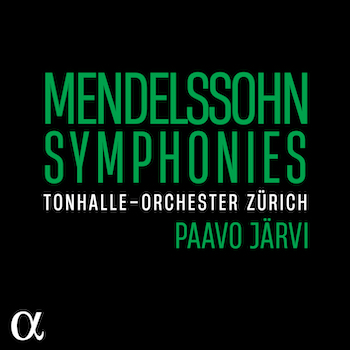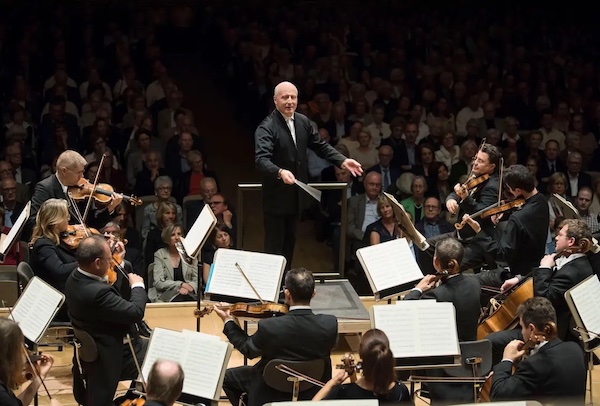Classical Music Album Review: Mendelssohn’s Complete Symphonies
By Jonathan Blumhofer
13 May 2024
The Tonhalle-Orchester Zürich recording of Mendelssohn’s Symphonies doesn’t cast the composer as a radical, but the effort highlights the strengths of his music and finds ways to put distinctive interpretive stamps on several of these scores.
 According to the pianist Andras Schiff, Felix Mendelssohn is a “very underrated” composer. Conductor Paavo Järvi feels the same way: “I don’t think Mendelssohn gets the attention he deserves” the maestro offered before undertaking a survey of the Romantic icon’s five symphonies and incidental music for A Midsummer Night’s Dream.
According to the pianist Andras Schiff, Felix Mendelssohn is a “very underrated” composer. Conductor Paavo Järvi feels the same way: “I don’t think Mendelssohn gets the attention he deserves” the maestro offered before undertaking a survey of the Romantic icon’s five symphonies and incidental music for A Midsummer Night’s Dream.
The recording of that project with the Tonhalle-Orchester Zürich is out now and, while it doesn’t cast Mendelssohn as a radical (which he wasn’t – not exactly), it highlights the strengths of his music and finds ways to put distinctive interpretive stamps on several of these scores.
To be sure, Mendelssohn’s five entries in the genre are a quirky lot. The Second, subtitled “Lobgesang” (“Hymn of Praise”) is a hybrid symphony-cantata written to commemorate the 300th anniversary of Guttenberg’s printing press. In the Third, Mendelssohn toyed with through-composed form: each of the work’s four movements are meant to proceed without pause, a concept Schumann was experimenting with at the same time. No. 5 marks the anniversary of the Reformation with a finale based on Martin Luther’s hymn “Ein’ feste Burg ist unser Gott.”
Additionally, they were published out of order: after No. 1 came No. 5, then Nos. 4, 2, and 3.
Regardless, the pentad clearly hails from the same pen and, together, offers a remarkable degree of variety that doesn’t always come through in performance or on disc. Here, though, Järvi manages to get the music to speak persuasively largely by virtue of smart tempos, flexible phrasings, and the highly attentive, virtuosic playing of his Zürich ensemble.
The First Symphony, written when Mendelssohn was just fifteen, is taut and driving, its counterpoint clean and well-shaped, and the slow movement’s lyricism lean and fluent. In the Fifth, Järvi’s approach to the music pays greater dividends.
Again, rhythms are tight, balances clean, and articulations crisp. The finale’s chorale statement is strongly shaped, while that movement’s later contrapuntal textures sound fresh and the music’s chromatic inner lines speak well. Also, the main sections of the outer movements are clearly sculpted: while there’s plenty of drive and intensity in the Tonhalle-Orchester’s playing, the lyrical sections breathe naturally and certain of the music’s antiphonal elements come out pleasingly.
More of the same follows in the Fourth which, for all its first-movement exuberance, manages to sing with warmth and grace. The concluding tarantella snaps right along, its central fugue unfurling with inviting energy.

Paavo Järvi conducing the Tonhalle-Orchester Zürich in 2018. Photo: Priska Ketterer / Tonhalle Orchester Zürich
Conductor, orchestra, and vocal guests seem to have a lot of fun with the Second, which was beautifully served a few years ago by Andrew Manze and the NDR Radiophilharmonie on Pentatone. With the present forces, tempos are lively, there’s plenty of rhythmic clarity, and a compelling sense of direction throughout.
The work’s choral contributions sometimes push the orchestra back in the mix, though the Zürcher Sing-Akademie’s blend and diction are both excellent. Similarly impressive are the performance’s soloists – sopranos Chen Reiss and Marie Henriette Reinhold, and tenor Patrick Grahl – who imbue their various moments with color and urgency.
Despite some idiosyncratic interpretive gestures (like a questionable diminuendo at the end of the chorus “Die Nacht ist vergangen”), the chorale on “Nun danket, alle, Gott” is devotional and the final chorus invigorating.
Likewise stimulating is Järvi’s take on the Third Symphony. Here, the orchestra revels in the music’s play of color, rhythm, and character. Woodwind figurations in the Scherzo are exquisitely on-point, the subtle play of light and shade in the Adagio is sublime, and the flexibility of phrasing in the outer movements ensures that the score’s larger scaffolding sounds rightly majestic.
Filling out the set is Mendelssohn’s incidental music to A Midsummer Night’s Dream, a programming choice that neatly frames the symphonies: he wrote the Overture just after completing No. 1 and the rest of the selections around the time he was finishing up No. 3 (which, as we might recall, was really his last).
Järvi and the Tonhalle-Orchester, joined this time by the ladies of the Zürcher Sing-Akademie and sopranos Katharina Konradi and Sophia Burgos, deliver a reading that’s energetic and, oftentimes, quietly tempestuous. Highlights include a limber, articulate account of the Scherzo; an unsentimental, richly blended, and rhythmically lucid take on the Nocturne; and a bewitching, elfin rendition of the finale.
Jonathan Blumhofer is a composer and violist who has been active in the greater Boston area since 2004. His music has received numerous awards and been performed by various ensembles, including the American Composers Orchestra, Kiev Philharmonic, Camerata Chicago, Xanthos Ensemble, and Juventas New Music Group. Since receiving his doctorate from Boston University in 2010, Jon has taught at Clark University, Worcester Polytechnic Institute, and online for the University of Phoenix, in addition to writing music criticism for the Worcester Telegram & Gazette.
https://artsfuse.org/292201/classical-music-album-review-mendelssohns-complete-symphonies/
Comments